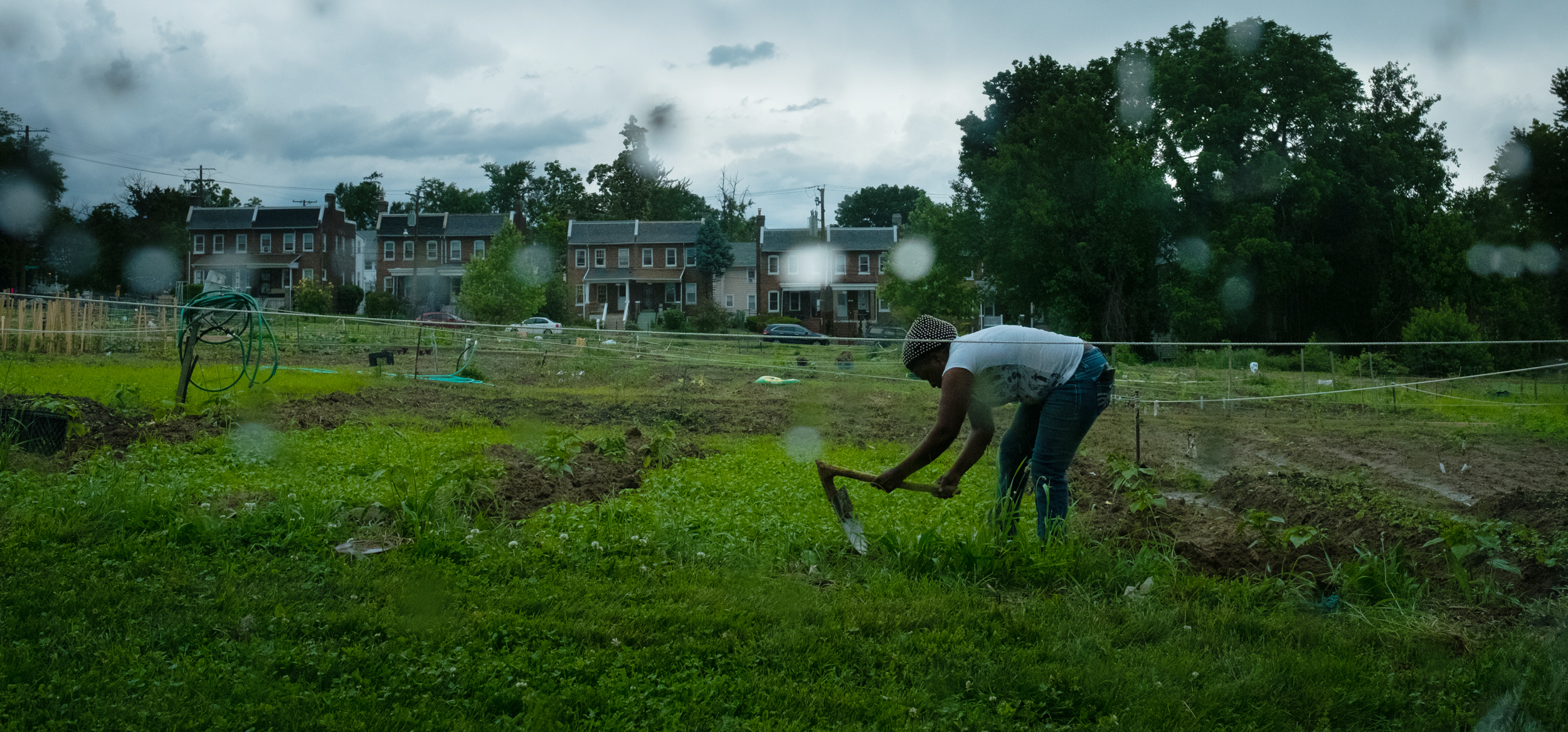
<p>Regina Mabah plants items from her home country of Cameroon in a community garden on the corner of 9th Street and Peabody Street NW in Washington, DC, on May 25, 2017 as a storm rolls in. (Photo by Sarah L. Voisin/The Washington Post via Getty Images)</p>
The buildings we live in, the parks we play in, the streets we walk on, and the pipes that run under our homes are all components of the built environment that influence our health outcomes. Our neighborhoods, our incomes, and our race often determine the quality of the built environment around us.
Communities of color and neighborhoods with higher levels of poverty are most likely to experience barriers to accessing quality housing, transportation, parks, recreation facilities, and other health-promoting aspects of the built environment because of systemic disinvestment, racist policies, and a lack of resident input in local decisionmaking. These barriers can lead to health inequities between white communities and communities of color, as well as between neighborhoods with higher incomes and those with lower incomes (PDF).
To ensure all residents have equitable opportunities to achieve good health, municipal leaders and nonprofit partners could consider reexamining and applying a health equity lens to the systems and policies affecting their communities’ built environments. Applying a health equity lens would require all community stakeholders—from municipal staff to public health officials, to community organizations and advocates—to pursue antiracist planning principles and processes and make targeted investments in underserved neighborhoods so residents have access to the same healthy environments as their more-resourced counterparts.
For a new brief, we spoke with municipal staff, health care departments, and local health advocacy organizations in 18 small- and medium-size municipalities to understand how they are implementing built-environment policies, plans, and programs to improve health outcomes and increase health equity. Here are four strategies these municipalities are taking.
1. Advancing inclusive resident engagement and collaboration
The municipal officials and nonprofits we spoke with are forging stronger relationships with communities and engaging residents who have experienced systemic neighborhood disinvestment to ensure buildings, roads, parks, and other physical assets are built and maintained to meet their needs.
Some local governments have invested in departments of resident engagement, created cultural ambassador positions, and are providing translation services at public events. For others, the process has been less formal. For example, city officials in South Bend, Indiana, reported that a staff member joined a neighborhood soccer team in order to gain a better understanding of community members’ perceptions of and desires for a new park project.
2. Prioritizing resources for communities experiencing health inequities
Data on health outcomes by race, income level, and neighborhood can tell city officials which communities experience the worse health outcomes and then inform their distribution of resources, funding, and allocation of staff time toward healthy interventions in these neighborhoods. The Neighborhoods of Focus Initiative (PDF) in Lansing, Michigan, conducts asset-based community development modeling to select neighborhoods that can reserve targeted investments and then jump to the top of the line for funding when new city resources become available. Several municipalities we spoke with are also using health impact assessments to identify a project’s potential health-related effects and pursue recommendations for how the project can minimize health risks and maximize health benefits.
3. Formalizing staffing roles and structures and training staff to listen
To increase equitable development across policy areas and programs, municipalities are beginning to hire chief equity officers and develop equity frameworks to inform their systems and approaches. Tempe, Arizona, is developing an Equity in Action plan to increase engagement with underrepresented populations in city planning and decisionmaking, and Kalamazoo, Michigan, hired a diversity, equity, and inclusion director in early 2020 who will sit in the city manager’s office.
For stakeholders working in communities, understanding community context is crucial to successful engagement. Local governments, service providers, and their partners can work toward a more just power distribution by training staff in inclusive communication, listening, and bias recognition. In Spokane, Washington, the regional health district is providing unconscious bias training to department staff and helping them understand how their work interacts with health equity. In Lansing, Michigan, the economic development and planning department received active listening training to better understand residents’ challenges in keeping properties up to code and to implement a plan based on what they learn from residents.
4. Acknowledging and understanding how residents interact with the built environment and mitigating potential adverse effects of built-environment interventions
In addition to thinking about possible health-promoting benefits of built-environment interventions, cities should consider these interventions’ potential adverse effects and work to mitigate them. New home construction, transportation upgrades, and the development of parks, trails, and green spaces can increase housing prices in a neighborhood and displace long-term residents.
Even when cities implement built-environment interventions, residents may still face barriers to use. Planning officials should consider who will benefit from a new bike lane or park and who may face discrimination or feel unsafe occupying these spaces. City officials we spoke with emphasized that implementation was only one piece of a successful intervention. It is equally important to understand barriers to access and to promote the use of healthy built-environment infrastructure through multilingual outreach campaigns and programming to ensure all residents can take advantage of the space.
In planning and implementing built-environment interventions, prioritizing and understanding the experience of populations with barriers to healthy environments can help promote health equity for all residents.
Let’s build a future where everyone, everywhere has the opportunity and power to thrive
Urban is more determined than ever to partner with changemakers to unlock opportunities that give people across the country a fair shot at reaching their fullest potential. Invest in Urban to power this type of work.